An ideal gas is taken through the cycle A→B→C→A, as shown in the figure. If the net heat supplied to the gas in the cycle is 5 J, what is the work done by the gas in the process C→A
 Solution in Telugu
Solution in Telugu
−5J
−10J
−15J
−20J
The correct Answer is:A
Step by step video, text & image solution for An ideal gas is taken through the cycle A rarr B rarr C rarr A, as shown in the figure. If the net heat supplied to the gas in the cycle is 5 J, what is the work done by the gas in the process C rarr A by Chemistry experts to help you in doubts & scoring excellent marks in Class 11 exams.
Topper's Solved these Questions
- BOOK - AAKASH SERIESCHAPTER - CHEMICAL THERMODYNAMICSEXERCISE - OBJECTIVE EXERCISE - 2 (E,H , HEAT CAPACITIES)7videos
CHEMICAL THERMODYNAMICS
- BOOK - AAKASH SERIESCHAPTER - CHEMICAL THERMODYNAMICSEXERCISE - OBJECTIVE EXERCISE - 2 (HEAT OF FORMATION AND COMBUSTION)10videos
CHEMICAL THERMODYNAMICS
- BOOK - AAKASH SERIESCHAPTER - CHEMICAL THERMODYNAMICSEXERCISE - OBJECTIVE EXERCISE - 1 (ENTORPY AND GIBBS ENERGY)42videos
CHEMICAL THERMODYNAMICS
- BOOK - AAKASH SERIESCHAPTER - CHEMICAL THERMODYANMICS EXERCISE - Questions For Descriptive Answers28videos
CHEMICAL THERMODYANMICS
- BOOK - AAKASH SERIESCHAPTER - ELECTRON MIGRATION EFFECTS EXERCISE - QUESTIONS FOR DESCRIPTIVE ANSWERS10videos
ELECTRON MIGRATION EFFECTS
Similar Questions
A gas absorbs 100 J of heat and is simultaneously compressed by a constant external pressure of 1.5 atm from a volume of 8.0L to 2.0L. The change in internal energy for the gas in Joules is (1L - atm = 101.32 J))
02:28View SolutionGiven that 12S8(s)+6O2(g)→4SO3(g),ΔH0=−1590kJ. The standard enthalpy of formation of SO3 is
05:27View Solution1st law does not tell about
01:30View SolutionHow does heat of neutralisation value change with the chemical nature of acid and base?
04:53View SolutionHyperconjugation effect is also termed as 'no bond resonance'. Why?
02:55View SolutionAn ideal gas is taken through the cycle A→B→C→A, as shown in the figure, If the net heat supplied to the gas in the cycle is 5J, the work done by the gas in the process CtoA is
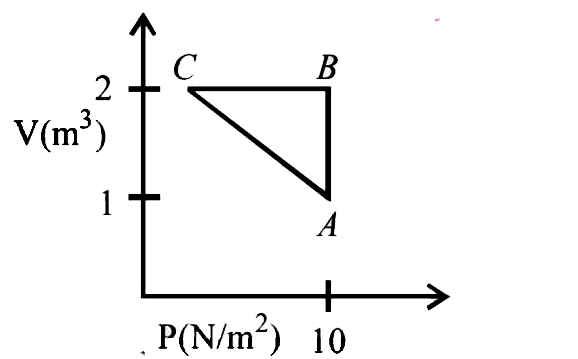 View Solution
View SolutionAn ideal gas (2.0 moles) is carried round a cycle as shown. If the process b→c is isothermal and CV=3cal/mol/K. Determine
a. work done,
b. change in internal energy,
c. heat supplied to the system during processes a→b, b→c and c→a.View SolutionA gas is taken through the cycle A→B→C→A, as shown in figure, what is the net work done by the gas?
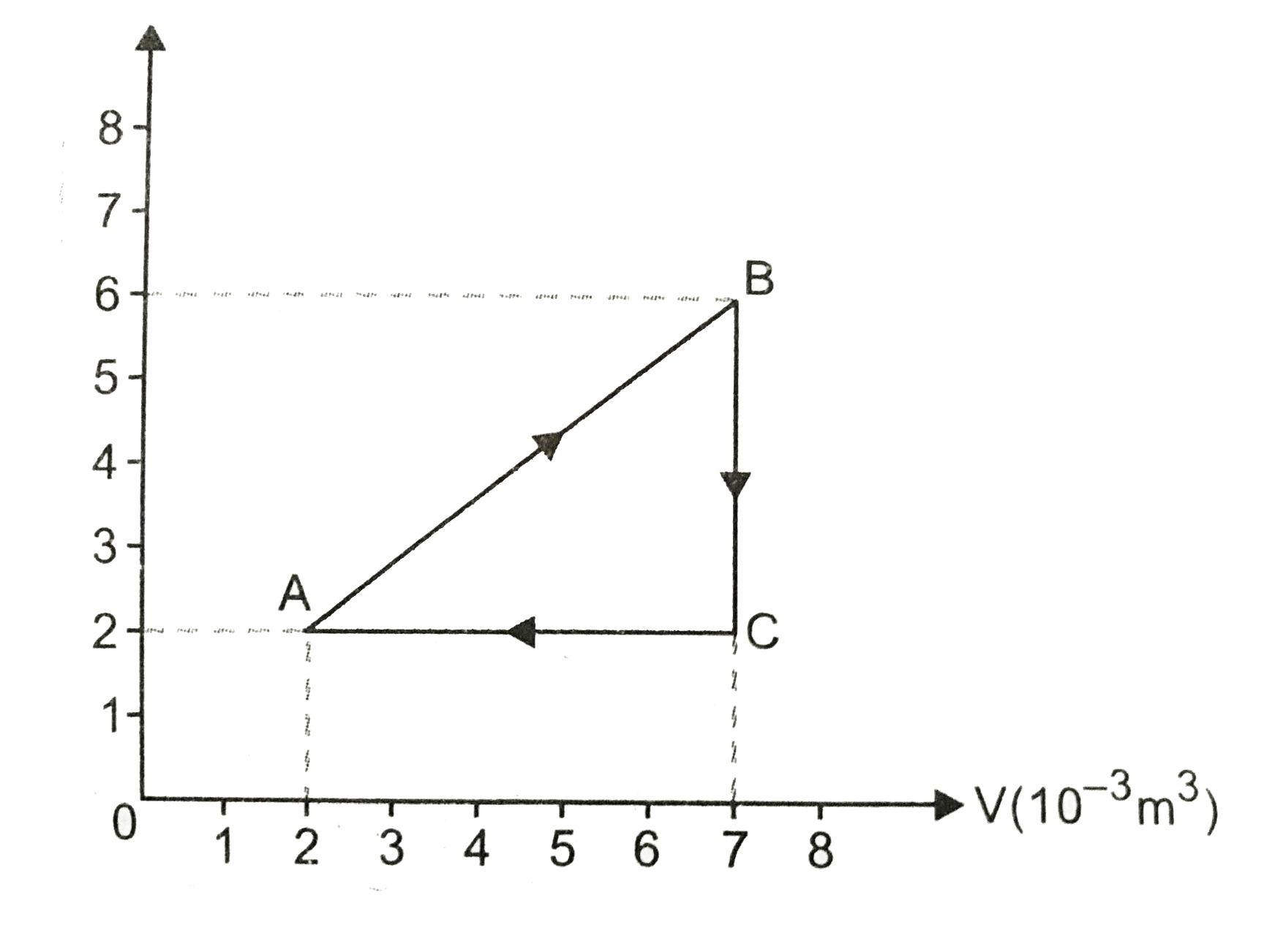 02:57View Solution
02:57View SolutionAn ideal gas is taken through the cycle A→B→C→A As shown in figure. If net heat supplied to the gas in the cycle is 5j. Find the work done by the gas in the process C→A in Joule (taken mole value)
 02:55View Solution
02:55View SolutionAn ideal gas is taken through the cycle A→B→C→A as shown in the figure . If the net heat supplied to the gas in the cycles is 5J. The magnitude of word done during the process C→A is
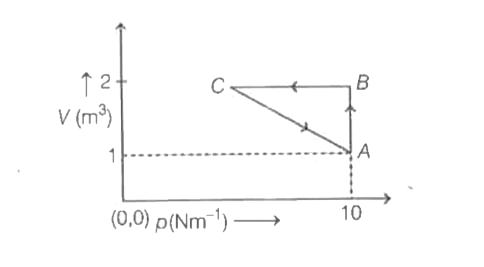 03:24View Solution
03:24View SolutionAn ideal gas is taken through the cycle A rarr B rarr C rarr A , as shown in figure. If the net heat supplied to the gas in the cycle is 5J, the work done by the gas in the process C rarr A is
01:36View SolutionA gas is taken through the cycle A→B→C→A, as shown. What is the net work done by the gas ?
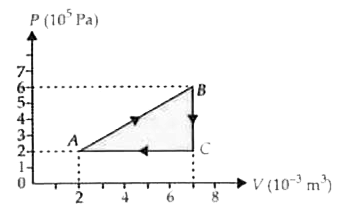 01:41View Solution
01:41View SolutionAn ideal gas is taken through the cycle AtoBtoCtoA , as shown in the figure. If the net heat supplied to the gas in the cycle is 5 J, the work done by the gas in the process CtoA is
02:38View SolutionIn a cyclic process shown in the figure on ideal gas is adiabatically taken from B to A, the work done on the gas during the process B rarr A is 30J, when the gas is taken from A rarr B the heat absorbed by the gas is 20J. What is the change in internal ebergy of the gas in the process A rarr B .
10:49View SolutionAn ideal gas is taken through the cycle A rarr B rarr C rarr A , as shown in the figure. If the net heat supplied to the gas in the cycle is 5 J, what is the work done by the gas in the process C rarr A
03:04View SolutionAn ideal gas is taken through the cycle A→B→C→A as shown in figure. If net heat supplied to the gas in the cycle is + 5 J, what is the work done (in J) by the gas in the process C→A?
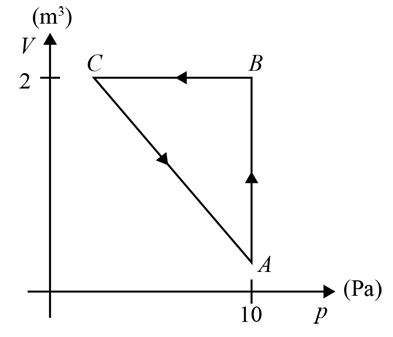 01:35View Solution
01:35View Solution

